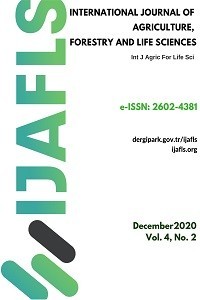FLORISTIC COMPOSITION AND SOIL CHARACTERISTICS OF PLANTATION FOREST IN NORTHWEST SAMAR STATE UNIVERSITY, SAN JORGE CAMPUS
FLORISTIC COMPOSITION AND SOIL CHARACTERISTICS OF PLANTATION FOREST IN NORTHWEST SAMAR STATE UNIVERSITY, SAN JORGE CAMPUS
Floristic composition, soil characteristics,
___
- Agbede, O.O. 2008. Soil Husbandry: Life for National Food Security and Economic Empwerment. An Inaugural Delivered on March 19th, 2008 at Nasarawa State University Keffi, Nigeria. Bremner, J.M. and C.S. Mulvany. 1982. Nitrogen – Total. In: A. L. Page, R.H Miller and D.R. Keeney (eds). Methods of Soil Analysis: Part 2. Chemical and Microbiological Properties. Agron. Monogr. 9. (2nded). ASA and SSSA, Madison, WI. 612 - 613. Deekor, T.N., Iwara, A. I., Ogundele, F. O., Amiolemen, S. O., Ita, A. E. 2012. Changes in Soil properties Under Different Land Use Covers in Parts of Odukpani , Cross River State, Nigeria. Journal of Environment and Ecology, ISSN 2157-6092 Eni, D.D., Iwara, A.T. and Offiong, R.A. 2012. Analysis of Soil-Vegetation Interrelationships in South-Southern Secondary Forests of Nigeria. International Journal of Forestry Research. Hindawi Publishing Corporation. 8 pp. Genxu, W., M. Haiyan, Q. Ju and C. Juan. 2004. Impact of land use changes on soil carbon, nitrogen and phosphorus and water pollution in an arid region of Northwest China. Soil Use and Management 20: 32-39. INTERNATIONAL SOIL REFERENCE AND INFORMATION CENTER (ISRIC). 1995. Procedures for soil analysis (L.P. Van Reuwijk, Editor). Wageningen, the Netherlands. pp.106. Landon, J.R. 1991.Booker tropical soil manual.Longman Scientific and Technical, England.474 pp. Nelson, D.W. and L.E Sommers. 1982. Methods of soil analysis, Part 2. American Society of Agronomy-Soil Science Society of America, 677 South Segoe Road, Madison, WI 53711, USA Otuoma,J., Ouma, G., Okeyo, D. Anyango, B. 2014. Species composition and stand structure of secondary and plantation forests in a Kenyan rainforest. Retrieved on February 18, 2016 from http://www.academicjournals.org/JHF. Shoji, S., Nanzyo, M., and Ahlgren, R.A., 1993. Volcanic ash soils.Genesis, properties and utilization.Developments in Soil Science 21, Elsevier, Amsterdam, 288 pp. Tesema, G.2008. Assessment of soil acidity in different land use types: The case of Ankesha Woreda, Awi Zone, Northeastern Ethiopia. M.Sc., Thesis, Addis Ababa University, Ethiopia. Yang, X., W.M. Post, P.E. Thornton, and A. Jain. 2013. The distribution of soil phosphorus for global biogeochemical modeling. Biogeosciences 10: 2525 2537. Yimer, F., Liden, S., Abdulakdir, A. 2008. Changes in soil organic carbon and total; nitrogen contents in three adjacent ;and use types in the Bale mountains, Southeastern Highlands of Ethiopia. For. Ecol. Manag.242:337-34.
- Yayın Aralığı: Yılda 2 Sayı
- Başlangıç: 2017
- Yayıncı: Volkan OKATAN
ADSORPTION CAPACITY FOR THE REMOVAL OF ORGANIC DYE POLLUTANTS FROM WASTEWATER USING CAROB POWDER
SITE QUALITIY EVALUATION OF SOILS IN DEGRADED UPLANDS OF INOPACAN, LEYTE AND STA. RITA, SAMAR
Nihal BAGY, Mohaemd ABDEL-RAHMAN, Mohamed MORSY, Gaber ABOU-ELHAGAG
DETERMINATION OF ENSILING POSSIBILITIES OF PLANTAGO LANCEOLATA L.
Asuman ARSLAN DURU, Ercüment Osman SARIHAN, İbrahim BULDUK
Jessie SABIJON, Derby POLIQUIT
CLIMATE CHANGE MITIGATION AND ADAPTATION THROUGH BIOTECHNOLOGY APPROACHES: A REVIEW
